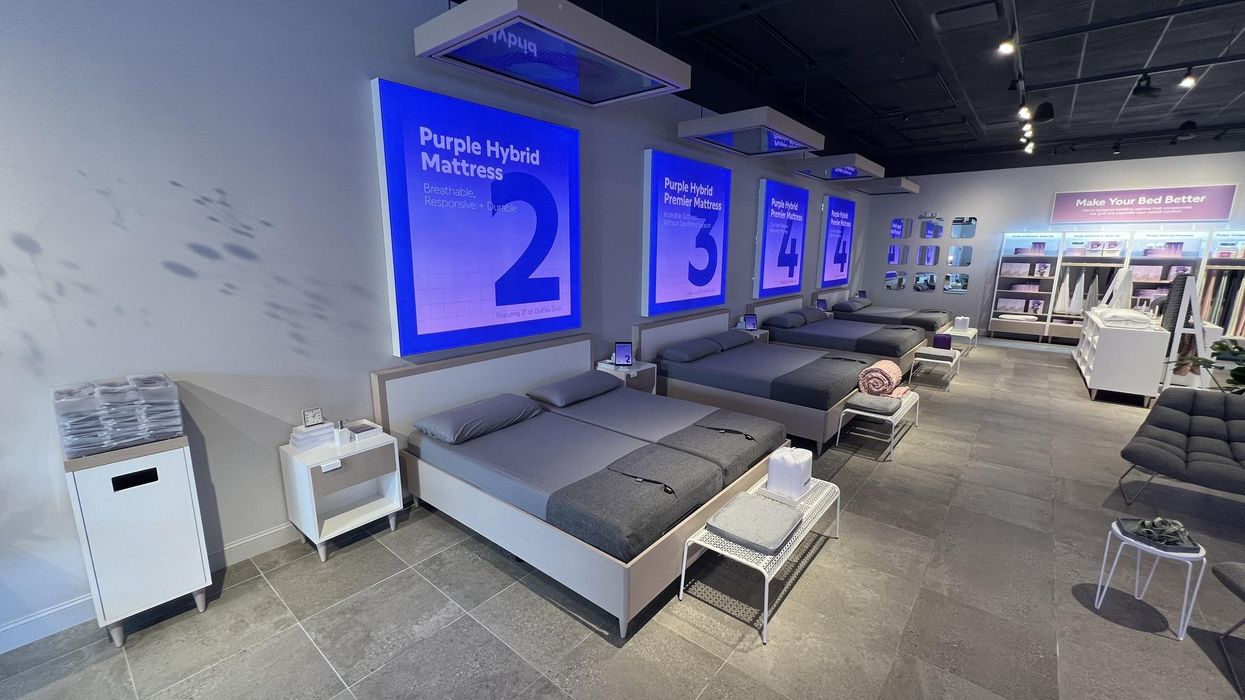Brand News
11 November 2022
Purple ramps up wholesale, store expansion
Bainbridge Growth spotlights a significant mix shift at the DTC mattress brand.

Inside a Purple Mattress showroom. (Courtesy photo)
Bainbridge Growth spotlights a significant mix shift at the DTC mattress brand.

This post originally appeared on the blog of Bainbridge Growth. It is being republished by The Current with permission.
Brothers Tony and Terry Pearce combined their experience in carbon fiber and polymers to invent the cushiony material that became Purple’s mattresses. Their interest in elastic polymers began in the late 1980s, and the duo eventually accumulated over 30 patents used in medical devices and shoes. Purple Innovations began in 2015 with capital the founders sourced from a highly successful Kickstarter campaign that brought in approximately $172,000. The Pearce brothers created their first king-sized mattresses and began selling them online. Sales growth driven by the monochannel ecommerce approach came very quickly and in 2017, Purple went public via a special-purpose acquisition company at a valuation of $1.1 billion.
The company describes itself as a “digitally-native vertical brand," manufacturing various comfort products developed over the last three decades. GelFlex Grid is their proprietary gel technology and is the core input to many of their products. These gel polymer innovations were the mattress industry’s cutting-edge technology over the last decade. DTC brands like Casper and Purple took the gel top layer much further, developing springless foam and gel-based mattresses that could be sold online and shipped to customers in tubes.
The pandemic was a roller coaster for the company, as they initially furloughed 35% of staff in Spring 2020, only to hire back over 900 people in 2H 2020 to support the home goods growth surge. YoY growth peaked at just over 50% during the stimulus boost of Q2 2021. Throughout the second half of 2021, the company experienced significant inventory shortages,leading to reduced sales and turnover among top executives. Former New Balance executive Robert DeMartini took over as CEO in December 2021. Analysts attributed the company’s 2021 difficulties to a blend of internal issues and market saturation but also mentioned that the company assets (gel patents) would be “attractive to many inside and outside the industry”.
In the recently reported second quarter of 2022, Purple Innovation saw net revenue decline 21% YoY to $144 million. This compares to management’s mention of a 1H 2022 decline in the total domestic mattress market of 25%. From a sales channel perspective, PRPL saw a 6% drop in wholesale and a 30% fall in DTC. These YoY declines resulted in a shifting business mix in the quarter, with revenue consisting of 57% DTC (64% in Q2 21) and 43% wholesale (36% in Q2 21). The underwhelming consumer demand led the management team to cut guidance on revenue to $570M to $590M ($650M to $690M prior) and reduced EBITDA expectations to -$15M to -$5M (Prior $21M to $27M).

Source: Purple Innovations Investor Relations
Gross margin fell from 44.7% in Q2 2021 to 33.9% in Q2 2022. This drop was driven by discounting in the DTC channel and a significant mix shift toward wholesale, even as the company opened 27 stores over the last twelve months to end Q2 2022 at 40. Wholesale distribution points were 3200 as of the end of Q2 2022, up by nearly 1000 on a YoY basis.
The decline in gross margin also reflects elevated costs of materials, labor, and overhead partially offset by labor force restructuring that occurred in February 2022 (the number of layoffs was undisclosed). Purple expects the full-year gross margin to be in the 35% to 37% range, as significantly more business comes from wholesale channels on a full-year 2022 basis. Pre-pandemic comparisons show FY19 gross margin at 44%, on a 62% DTC revenue mix.

Source: Purple Innovations Investor Relations
The company’s operating expenses as a percent of revenue were 42.3% in Q2 22, vs 46.1% in Q2 21. A substantial decrease in advertising drove this decline. Purple drastically cut advertising spend in the quarter, reducing it by $24.1 million or 56% vs Q2 21. Leadership wants to maintain this ad spend ratio of 30% of revenue on a go-forward basis, as one of their four core business initiatives is an intentional move away from performance marketing and toward brand spend. The team is very excited about their new marketing campaign, “Overnight Success”, which they launched on linear TV, online video, and social media. This strategy is aligned with their focus on growing store count in DTC and distribution points in the wholesale channel.

The question going forward is if Purple’s rapid expansion into more physical showrooms can offset their declines in online sales. This will likely be a hard lift, as Casper and Purple (to a lesser extent) have become the primary examples of DTC’s potential to oversaturate a market. Mattress brands caught the DTC wave early with huge ad spend, achieving significant sales growth only to struggle with profitability post-IPO.
A decade ago, mattresses were still a high margin heavily sales commissioned product, with customers unable to easily compare products and prices. Now the DTC sleep brands face similar threats primarily from each other as mattresses delivered in tubes and boxes have become an intensely competitive segment.
On the Move has the latest from Amazon, Lovesac and more.
Ryan Cohen is executive chairman of GameStop. (Photo by Flickr user Bill Jerome, used under a Creative Commons) license.
This week, leadership is changing at GameStop, Sorel and Beautycounter. Meanwhile, key executives are departing at Amazon, Wayfair and Lovesac.
Here’s a look at the latest shuffles:
GameStop announced the termination of Matthew Furlong as CEO on Wednesday. A brief statement did not provide a reason for the firing.
With the move, Chewy founder and activist investor Ryan Cohen was named executive chairman of the video game retailer. Cohen will be responsible for capital allocation and overseeing management.
It came as the company reported a 10% year-over-year decline in net sales for the first quarter. Meanwhile, the company’s net loss improved by 62%.
In an SEC filing, GameStop further added this “We believe the combination of these efforts to stabilize and optimize our core business and achieve sustained profitability while also focusing on capital allocation under Mr. Cohen’s leadership will further unlock long-term value creation for our stockholders.”
Cohen was revealed as GameStop's largest shareholder when he disclosed a 10% stake in the retailer in 2020. GameStop went on to become a leading name in the meme stock rise of 2021.
Mark Nenow is stepping down as president of the Sorel brand in order to focus on his health.
After rising to the role in 2015, Nenow spearheaded a transformation of Columbia Sportswear-owned Sorel from a men’s workwear brand to a fashion-focused brand that led with a women’s offering of boots, sandals and sneakers.
“Mark led the brand to sales of $347 million in net sales in 2022,” said Columbia Sportswear CEO Tim Boyle, in a statement. “His leadership has been invaluable to this company, and we wish him the very best.”
Columbia will conduct a search for Nenow’s replacement. Craig Zanon, the company’s SVP of emerging brands, will lead Sorel in the interim.
Beautycounter appointed board member Mindy Mackenzie as interim CEO, succeeding Marc Rey. According to the brand, Rey and the board “mutually decided to transition to a new phase of leadership for Beautycounter.”
McKenzie, a former executive at Carlyle, McKinsey and Jim Beam, will lead the company as it conducts a search for a permanent CEO. Additionally, former Natura & Co CEO Roberto Marques will join Beautycounter’s board as chair.
As part of the transition, Nicole Malozi is also joining the company as chief financial officer. She brings experience from Tatcha, Nike, and DFS Group Limited.
Melissa Nick, a VP of customer fulfillment for North America at Amazon, will leave the company, effective June 16, CNBC reported. Nick joined the company in 2014, and oversaw a region that included nearly 300 fulfillment centers. After doubling its supply chain footprint during the pandemic, Amazon recently reorganized its fulfillment operations to take a regional approach, as opposed to a national model that often resulted in items shipping across the country.

Jon Blotner (Courtesy photo)
Steve Oblak will retire from the role of chief commercial officer at home goods marketplace Wayfair. With the move, Jon Blotner will be promoted to chief commercial officer.
"Steve has served as a critical part of our leadership team and played a pivotal role in Wayfair's growth, helping us grow from a $250 million business when he joined to $12 billion in net revenue today,” said Wayfair CEO Niraj Shah, in a statement. “He oversaw countless milestones, from helping to launch the Wayfair brand as we brought together hundreds of sites into a single platform, to launching new categories, business lines, and geographies while overseeing our North American and European businesses, to leading our debut into physical retail.”
Blotner previously oversaw exclusive and specialty retail brands, as well as digital media at Wayfair. Before joining the company, he served as president of Gemvara.com prior to its 2016 acquisition by Berkshire Hathaway.
Furniture retailer Lovesac said Donna Dellomo will retire as EVP and CFO, and move to an advisory role, effective June 30. Dellomo was with Lovesac for six years.
Keith Siegner was appointed as the next EVP and CFO. He brings experience as CFO of esports company Vindex, as well as executive roles at Yum! Brands, UBS Securities and Credit Suisse.
Additionally, Jack Krause will retire from the role of chief strategy officer, effective June 30. His responsibilities will be divided between CEO Shawn Nelson and president Mary Fox.
“Since joining Lovesac, Jack has played an instrumental role in transforming the Company into a true omni channel retailer by helping expand our physical touchpoints and digital platform as we continue to disrupt the industry,” said Nelson, in a statement.
The National Retail Federation announced the addition of five new board members. They include: